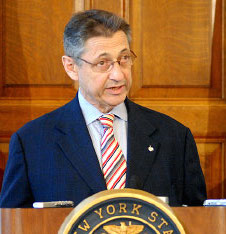
Skyrocketing public-pension obligations have generated concern across the country, especially in the wake of high-profile bankruptcies of Detroit and Stockton, Calif.
In New York, an even larger burden looms in the form of lifetime health-insurance coverage promised to state and local government employees.
Yet at least one house of the Legislature is considering a bill that would effectively prevent any effort to reduce this unaffordable debt.
Retiree health insurance (also known as other post-employment benefits, or OPEB) amounts to a $250 billion unfunded liability for the state, its public authorities and localities.
New York City’s share alone comes to $93 billion, according to its most recent comprehensive financial report.
And the cost for this isn’t covered out of multi-employer pension funds but out of current budgets. Beyond this year’s premiums, future New York taxpayers are on the hook for the rest — a quarter of a trillion dollars’ worth of benefits, due to flow for decades to come.
State lawmakers should be urgently looking for ways to reduce this burden at every level of government.
Instead, with less than a week to go in the session, a bill poised for a vote on the Senate’s floor calendar would virtually guarantee current levels of retiree health coverage for everyone on a public payroll in New York state.
Sponsored by Sen. Andrew Lanza (R-SI), the measure would bar any reduction in health benefits for retirees — including, by implication, active employees who haven’t retired yet.
Lanza’s proposal would build on the bad precedent created by then-Gov. David Paterson’s December 2009 Tier 5 pension bill, which pre-emptively locked at least $38 billion of long-term retiree-health-care liabilities into school-district collective-bargaining agreements.
Public-sector unions representing non-school employees have been seeking the same sort of “protection” for years, but earlier versions of the Lanza bill were vetoed by Govs. George Pataki, Eliot Spitzer and Paterson.
It’s hard to see how Gov. Cuomo could do anything different if the Lanza bill passes both houses and gets to his desk. Cuomo has sought to curb health costs for retired state employees in his last two budgets.
Even if the measure dies a natural death, the Legislature’s willingness to consider locking in these obligations highlights a huge disconnect between fiscal reality and a common mindset on both sides of the aisle in the state Capitol.
Lawmakers willing to make retiree health care untouchable are simply ignoring the implications of these unfunded liabilities for local governments across the state — especially declining upstate cities.
But even in more affluent suburban areas, the rising cost of health insurance for retirees and their dependents threatens to consume more and more scarce resources needed to fund basic services.
The vast majority of private-sector workers have no access to retiree health coverage other than Medicare, which kicks in at age 65 and includes a modest premium.
The good news for taxpayers is that public-sector retiree health benefits, unlike pensions, are not guaranteed by the state Constitution.
For now, at least, elected officials can still try to change course on retiree health care by restructuring benefits along more affordable lines for both current retirees and active employees.
It’s not enough for Cuomo to veto a bad bill, if it comes to that. Since the Legislature clearly is unwilling to take any positive steps to address the problem, the governor needs to take the lead in pushing for meaningful reforms, which would include an immediate prohibition on the creation of new unfunded liabilities for retiree health care.
He could also set an example for local governments by proposing a shift of state workers into private retirement medical trusts, supported by both employer and employee contributions, which would remove at least a portion of the OPEB obligation from the state’s balance sheet.
If Cuomo fails to take a strong pro-taxpayer stand on this issue, it creates an opening for his Republican opponent, Westchester County Executive Rob Astorino — whose county government faces its own unfunded OPEB liability of $2.3 billion.
It’s one thing for Cuomo to turn a deaf ear to local governments’ cries for relief from state mandates that drive up spending; it’s another for him to countenance what would amount to the mother of all mandates.
When it comes to locking in public-sector retiree health benefits, the Legislature needs a clear message from the top: “don’t even think of it.”






